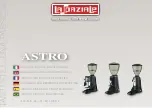
8 Care and maintenance
WARNING
Repairs to the electrical section of the power tool may
be carried out only by trained electrical specialists.
8.1 Care of the power tool
DANGER
When working on metal under extreme conditions, con-
ductive dust may accumulate inside the power tool. This
may negatively affect the power tool’s protective in-
sulation.
Under such conditions, the tool should be
plugged into a ground fault circuit interrupter (RCD)
and use of a stationary dust removal system and
frequent cleaning of the tool’s cooling air slots is
recommended.
Never operate the power tool when the air vents are
blocked. Regularly clean the power tool’s air vents care-
fully with a dry brush. Do not permit foreign objects to
enter the interior of the tool. The motor’s fan will draw
dust into the casing and an excessive accumulation of
conductive dust (e.g. metal, carbon fiber) may cause
electrical hazards. Clean the outside of the power tool at
regular intervals with a slightly damp cloth. Do not use
a spray, steam pressure cleaning equipment or running
water for cleaning. This may negatively affect the elec-
trical safety of the tool. Always keep the grip surfaces
of the tool free from oil and grease. Do not use cleaning
agents which contain silicone.
NOTE
Frequent work on conductive materials (e.g. metal, car-
bon fiber) may make shorter maintenance intervals ne-
cessary. Take your individual work place risk assessment
into account.
8.2 Checking the power tool after care and
maintenance
After carrying out care and maintenance work on the
power tool, check that all protective and safety devices
are fitted and that they function faultlessly.
9 Troubleshooting
Fault
Possible cause
Remedy
The power tool doesn’t start.
Interruption in the electric supply.
Plug in another electric appliance and
check whether it works.
The supply cord or plug is defective.
Have the parts checked by a trained
electrical specialist and replaced if
necessary.
The carbon brushes are worn.
Have it checked by a trained electrical
specialist and replaced if necessary.
The electronic restart interlock is ac-
tivated after an interruption in the
electric supply.
Switch the power tool off and on
again.
The power tool doesn’t achieve
full power.
The extension cord’s conductor cross
section is inadequate.
Use an extension cord with an ad-
equate conductor cross section.
10 Disposal
Most of the materials from which Hilti power tools or appliances are manufactured can be recycled. The materials
must be correctly separated before they can be recycled. In many countries, Hilti has already made arrangements for
taking back your old power tools or appliances for recycling. Please ask your Hilti customer service department or
Hilti representative for further information.
For EC countries only
Disposal of electric tools together with household waste is not permissible.
In observance of the European Directive on waste electrical and electronic equipment and its imple-
mentation in accordance with national law, electrical appliances that have reached the end of their life
must be collected separately and returned to an environmentally compatible recycling facility.
en
20
Printed: 21.05.2015 | Doc-Nr: PUB / 5169282 / 000 / 02
















































